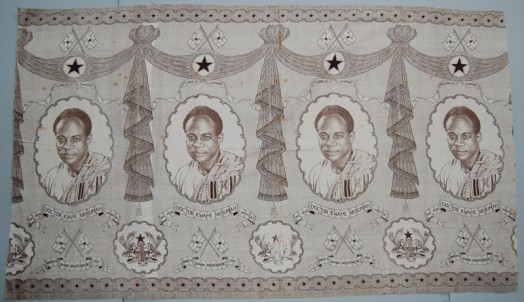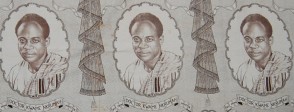
Decolonisation
Even before World War II, Britain was considering the cost of the long-term maintenance of overseas colonies. By the early 1950s many of these colonies, which had contributed so much to the war effort, had become increasingly confident and nationalistic. At the same time, Britain was impoverished by war, stripped of trade monopolies and increasingly aware of the questionable morality of colonialism, especially under pressure from the USA through the right to self-governance enshrined in the Atlantic Charter of 1941. In the Gold Coast, a campaign of civil disobedience coordinated by a young politician, Kwame Nkrumah, convinced British politicians of the need to move forward in granting independence. The Gold Coast’s relative wealth as an exporter of gold and cocoa made it a strong candidate for early independence. In 1957, Nkrumah became the first prime minister of newly independent Ghana, a name derived from a medieval West African empire. Ghana’s independence encouraged other African colonies to bring forward their own negotiations and by 1968 all but one of Britain’s former African colonies had gained independence.
The road to independence
Nkrumah, who had studied in the USA, became head of the United Gold Coast Convention (UGGC), a nationalist movement, in 1947. During 1948 tensions increased as ex-servicemen who had been discharged from the army were not given promised pensions on their return. In a peaceful march the police shot three veterans dead. Five days of riots followed after which the leaders of the UGGC, including Nkrumah, were arrested. Eventually finding the UGGC too conservative in its aims, Nkrumah set up the rival Convention People’s Party (CPP) to campaign for independence. The CPP appealed to a wider section of the population, not just the wealthy, and Nkrumah became well-known for his oratorical skills. Despite several arrests and periods in prison, Nkrumah led a campaign of strikes, demonstrations and boycotts which eventually forced Britain to abandon property and wealth qualifications for voting and to hold a full general election in 1951. This resulted in a landslide victory for the CPP and for Nkrumah, who was still in prison.
On Independence Day, 5 March 1957, Nkrumah spoke of the need for Ghana to create its own African personality and identity. One way to achieve this was in the naming of the country; another was to re-appropriate the rich pre-colonial heritage of the continent and that is what is illustrated on this cloth.
Reclaiming the past
Printed cottons like this one were and still are used to make clothing for supporters of a candidate during elections, and for other important political events. Repeated at the centre of each panel, Nkrumah is depicted wearing kente cloth. Historically, kente was a special textile worn by kings of Asante, one of the richest and most powerful kingdoms in West Africa. Kente is woven in strips and sewn together, each pattern bearing a particular significance in its colour and design.
Elements of the coat-of-arms also make links between Ghana’s past and present. One of the bottom quarters shows a gold mine, the historical source of Ghana’s great wealth. The king’s sword and a staff used by linguists in official ceremonies are traditional West African symbols of authority. The building in the top left quarter of the shield is Osu Castle, a slave trade fort, which was the seat of the British colonial government from the late 1800s, but was taken over by the national government in 1957. These distinctively African symbols sit alongside traditional European elements such as the shield, the supporting eagles and the Latin motto. The tree is a cocoa tree, introduced by Europeans in the nineteenth century and subsequently a source of wealth for Ghana.
However, the single most frequent motif on the cloth is a black star. The Black Star was first used by Marcus Garvey, the Jamaican writer, orator and proponent of black nationalism, with whose ideas Nkrumah first came into contact during his time in the USA. The Black Star became a symbol of Pan-Africanism, a global movement dedicated to unifying people of African descent. In his time as the first prime minister and then president of Ghana, Nkrumah was dedicated not only to ensuring the success of the newly independent country, but also to the cause of African unity.
More information
BBC profile of Ghana
http://www.bbc.co.uk/news/world-africa-13433790
BBC World Service article on Kwame Nkrumah
http://www.bbc.co.uk/worldservice/people/highlights/000914_nkrumah.shtml
Wrapped in Pride
Webpages of an exhibition at the Smithsonian National Museum of African Art about Ghanaian kente
http://africa.si.edu/exhibits/kente/about.htm
Timeline of the dates of independence of African countries
http://africanhistory.about.com/library/timelines/blIndependenceTime.htm
BBC article on Ghana's oil industry
http://www.bbc.co.uk/news/world-africa-11996983
History of the Ghana Black Stars national football team
http://www.ghanaweb.com/GhanaHomePage/blackstars/
British Museum article about African textiles
http://www.britishmuseum.org/about_us/news_and_press/press_releases/2013/african_textiles.aspx
Letter from Africa: Ghana's uniform lovers
BBC article on clothing in Ghana showing similar cloths being worn
http://www.bbc.co.uk/news/world-africa-30378181
More information
-
BBC profile of Ghana
Source: bbc.co.uk
-
BBC World Service article on Kwame Nkrumah
Source: bbc.co.uk
-
Wrapped in Pride
Webpages of an exhibition at the Smithsonian National Museum of African Art about Ghanaian kente
Source: si.edu
-
Timeline of the dates of independence of African countries
Source: about.com
-
BBC article on Ghana's oil industry
Source: bbc.co.uk
-
History of the Ghana Black Stars national football team
Source: ghanaweb.com
-
British Museum article about African textiles
Source: britishmuseum.org
-
Letter from Africa: Ghana's uniform lovers
BBC article on clothing in Ghana showing similar cloths being worn
Source: bbc.co.uk


